Crossref Citations
This article has been cited by the following publications. This list is generated based on data provided by Crossref.
Di Martino, Paolo
Felice, Emanuele
and
Vasta, Michelangelo
2020.
A tale of two Italies: ‘access-orders’ and the Italian regional divide.
Scandinavian Economic History Review,
Vol. 68,
Issue. 1,
p.
1.



